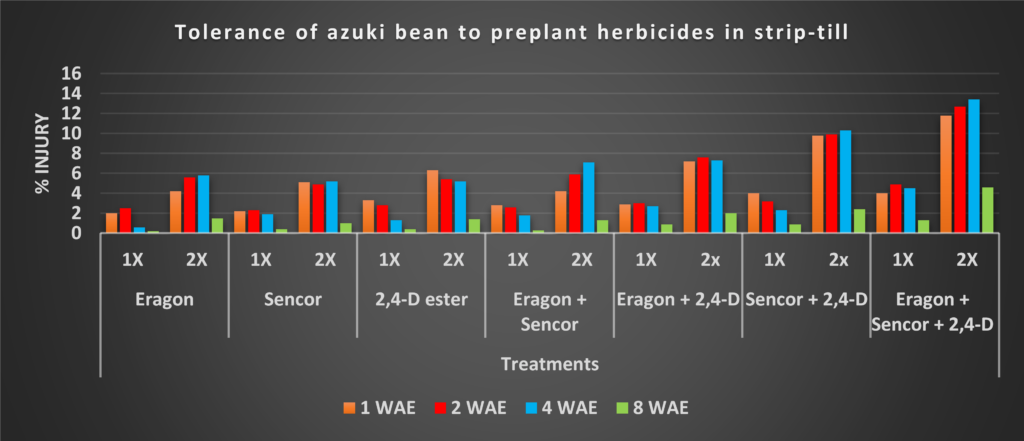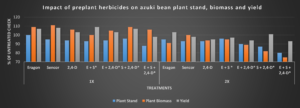Azuki bean growers are adopting minimum tillage practices with positive results. Reduced, strip and no-till in azuki bean presents new weed management challenges. Challenges such as glyphosate-resistant (GR) Canada fleabane control under similar tillage practices in soybean production are well known and herbicide options applied preplant are available in soybean. Azuki bean growers have limited herbicide options, even under conventional tillage, for weed management. Minimum tillage systems limit that even more with the inability to incorporate herbicides. Azuki bean growers need effective weed management options, especially for, difficult weeds like GR Canada fleabane. Identifying herbicide options for azuki bean growers so they can continue to adopt sustainable soil management practices is important for the growth of the industry.
Previous research identified Eragon, Sencor and 2,4-D ester applied preplant (PP) as possible weed management options in minimum-till azuki bean. These herbicides are not registered for use in azuki bean (Vigna angularis) in Ontario. Further information on azuki bean tolerance to these herbicides applied alone and as a tankmix is needed.
Evaluations
Five trials were conducted between 2018 and 2020 at the Huron Research Station evaluating azuki bean tolerance to Eragon, Sencor, 2,4-D ester, Eragon plus Sencor, Eragon plus 2,4-D ester, Sencor plus 2,4-D ester and Eragon plus Sencor plus 2,4-D ester applied PP. Rates evaluated were: Eragon at 29 ml/ac (1X) and 58 ml/ac (2X), Sencor 213 g/ac (1X) and 426 ml/ac (2X) and 2,4-D at 322 ml/ac (1X) and 644 ml/ac (2X). These rates were used when applied alone and as a tankmix. Rates were based on commonly used rates in soybean (1X) and twice those (2X) to simulate a spray overlap to ensure adequate azuki bean tolerance. Strip-till trials were set up with strips established the previous fall. Herbicide treatments were applied at approximately 7 days prior to planting. Trials were maintained weed-free throughout the growing season. Assessments included azuki bean injury 1, 2, 4 and 8 weeks after bean emergence (WAE), bean plant stand and biomass 3 WAE, bean height 6 WAE and bean yield.
Results – Crop injury
Azuki bean injury symptoms included delayed emergence, leaf strapping, stand reduction, growth reduction and necrosis.
Eragon: Azuki bean injury from Eragon 1 WAE ranged from 2% at the 1X to 4% at the 2X rate. Injury levels increased slightly up to 4 WAE at both rates and declined to less than 2% 8 WAE. Plant stand was reduced 5% at the 2X rate with a biomass reduction of 9%. There was no reduction in azuki bean yield at either rate of Eragon. Azuki bean has good tolerance to applications of Eragon applied PP.
Sencor: Azuki bean injury from Sencor ranged from 2% at the 1X and 5% at the 2X rate 1 WAE. Injury remained similar up to 4 WAE declining to less than 2% at 8 WAE. Plant stand was reduced 5% at the 1X rate and 7% at the 2X rate. There was no commercially significant plant biomass or yield reduction with Sencor applied PP. Azuki bean has good tolerance to PP applications of Sencor.

2,4-D ester: Azuki bean injury ranged from 3% at the 1X rate to 6% at the 2X rate 1 WAE. Injury levels slightly declined over time to less than 2% 8 WAE. Plant stand reductions ranged from 6 to 7% (1X and 2X) with plant biomass being reduced 6% at the 2X rate. Although not commercially significant, azuki bean yield was reduced 5% at the 2X rate. Azuki bean has good tolerance to PP applications of 2,4-D. Care must be taken to avoid spray overlaps and to ensure a minimum 7 day preplant application when 2,4-D is used.
Eragon + Sencor: Azuki bean injury with Eragon + Sencor ranged from 3% (1X) to 4% (2X) evaluated 1 WAE. Injury declined to less than 1% 8 WAE at the 1X rate. Injury increased slightly up to 4 WAE but declined to less than 2% at the 2X rate 8 WAE. There was no commercially significant reduction in plant stand, biomass or yield at either rate. Azuki bean has good tolerance to Eragon + Sencor applied PP.
Eragon + 2,4-D: Azuki bean injury with Eragon + 2,4-D ranged from 3% (1X) to 7% (2X) evaluated 1 WAE. Injury increased slightly up to 4 WAE but declined to less than 2% at the 2X rate 8 WAE. Plant stand was reduced 6% with no impact on biomass or yield at the 1X rate. Plant stand was reduced by 10%, biomass 11% and yield 6% at the 2X rate. Azuki bean has good tolerance to PP applications of an Eragon + 2,4-D tankmix. Care must be taken to avoid spray overlaps and to ensure a minimum 7 day preplant interval when 2,4-D is used.

Sencor + 2,4-D: Azuki bean injury with Sencor + 2,4-D ranged from 4% (1X) to 10% (2X) evaluated 1 WAE. Injury levels remained relatively unchanged up to 4 WAE and declined to 3% or less 8 WAE. Plant stand was reduced 4% with no impact on biomass or yield at the 1X rate. Plant stand and biomass were reduced by 13 and 18%, respectively, with no impact on yield at the 2X rate. Azuki bean has fair to good tolerance to PP applications of a Sencor + 2,4-D tankmix. Care must be taken to avoid spray overlaps and to ensure a minimum 7 day preplant interval when 2,4-D is used.
Eragon + Sencor + 2,4-D: Azuki bean were most susceptible to injury with the three-way tankmix. Azuki bean injury with Eragon + Sencor + 2,4-D ranged from 4% (1X) to 12% (2X) evaluated 1 WAE. Injury levels remained relatively unchanged up to 4 WAE and declined to less than 2% at the 1X and less than 5% at the 2X rate 8 WAE. Plant stand was reduced 12% with no impact on biomass or yield at the 1X rate. Plant stand and biomass were reduced by 20 and 25%, respectively, with a 7% reduction in yield at the 2X rate. Azuki bean has fair tolerance to PP applications of an Eragon + Sencor + 2,4-D tankmix. Care must be taken to avoid spray overlaps and to ensure a minimum 7 day preplant interval when 2,4-D is used.
Conclusions
Azuki bean has fair to good tolerance to all treatments evaluated. Tankmixes with 2,4-D increased injury with the three-way tankmix resulting in the greatest injury. Eragon, Sencor and 2,4-D applied alone or in combination show promise as PP herbicide options in azuki bean. Care must be taken to avoid spray overlaps and in treatments with 2,4-D a 7 day preplant interval must be followed.
None of these products are registered for use in azuki bean. Some export markets may have restrictions on MRLs for unregistered products, and detection of residues could significantly impact trade. Azuki bean growers should always follow label directions.
For further information please contact Peter Sikkema (psikkema@uoguelph.ca) or Todd Cowan (tcowan@uoguelph.ca)
This article was written by Todd Cowan and Peter Sikkema.